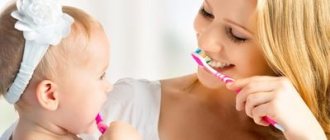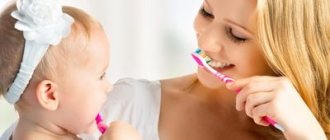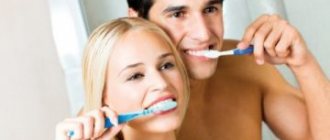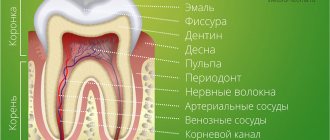Dental care begins in the first year of life, when the first milk teeth erupt. Particular attention should be paid during the period replacing baby teeth with molars
. And if any problems arise: malocclusion, uneven alignment, brackets are installed on the teeth to correct them.
Content:
- Differences between dental braces and braces
- Indications for use
- Contraindications
- Varieties
- Braces for children
- At what age is it best to use braces?
- How does the installation work?
- System care
When correcting malocclusion in adults and children, braces are often used. Compared to braces, they are removable, but you have to wear them longer. Visually, such leveling systems resemble wire arches running along the entire dentition.
Bottom line
Crooked teeth do not look aesthetically pleasing, which leads to the development of communication complexes. However, an ugly smile is not so bad. Uneven dentition leads to the formation of an incorrect bite, and this is fraught with the development of various pathologies of the digestive organs. Parents should bring their child to see an orthodontist as early as 7-8 years old to clarify problems with bite and dental alignment.
For adults, braces and staples are prescribed to correct bite pathologies. The wearing period of orthodontic structures after 25 years increases significantly due to the strong fixation of the roots of the teeth in the socket; however, braces even out the teeth of adults. The choice of braces depends on the financial condition of the patient, since the material of the products can be very expensive. The most affordable option is simple metal (or plastic) structures.
Staples provoke the accumulation of plaque, in which pathogenic bacteria actively multiply. To avoid inflammatory processes on the mucous membrane, use herbal rinses and antiseptic infusions.
Sources used:
- Persin L. S. Orthodontics, M., 1999
- Guide to prosthetic dentistry, ed. A. I. Evdokimova, M., 1974
- Ministry of Health of the Russian Federation
Differences between dental braces and braces
The designs work on the same principle. Even translated from English, the word “brace,” from which the term “braces” comes, means “bracket.” But there are significant differences between them.
So, braces cannot be removed by yourself. They consist of a corrective arc and separate locks. When installing them on the dentition, special dental glue is used. Models are classical and lingual. The latter are located on the inside of the dentition, so they are invisible to others. Braces are expensive.
Staples are removable devices. They are a complete and very simple system. They are held on the teeth thanks to mechanical fixation using rings and clasps that fit onto dental crowns. Prices for dental braces are relatively low.
What it is?
Braces are a metal product created by somatogamy specifically in order to put units of the dentition in place. Due to the fact that they move, it is possible to correct the bite.
Dental braces usually consist of several elements. All of them are durable, this allows you to correct both individual teeth and the position of the entire row as a whole.
As for metal structures, they can put pressure only on those units that are problematic, as a result of which the distance between them begins to decrease. This is extremely important for correcting incisors and tooth position. The doctor can change the pressure in the selected zone, and the design elements can change if necessary.
Teeth under construction require special care
The brackets consist of the following elements:
- Locks for fastening . They can be made of plastic, metal or ceramic.
- Metal arc - it connects individual locks. Moreover, the arc has a kind of memory effect. No matter how you try to bend it, it will try to return to its previous position. Due to this, the necessary pressure will be applied, the teeth will begin to move into the correct position.
- Rubber rings. They are used to ensure that the metal arch is fixed more reliably on the teeth.
- Spacers and separators . Elements allow you to adjust the distance between dental units.
- Elastic dentures – allow you to correct your bite.
Dentists are of the opinion that it is better to begin bite correction when the upper and lower jaws are in the stage of active growth. This age for children ranges from eight to fifteen years.
An example of how you can fix teeth with braces
If orthodontic measures were not carried out during this period, then in principle there is nothing to worry about. It is possible to get rid of dental anomalies in adulthood, but this will take an order of magnitude longer.
In adults, dental braces can be used after wearing braces to secure the results. The period of wearing an arch can be up to several years.
Contraindications
Situations when staples cannot be installed may vary. Temporary contraindications include:
- Poor oral hygiene. Then you first need to carry out professional hygiene.
- Untreated caries. First you need to “close” all carious cavities.
- Progressive pulpitis, periodontitis, periodontal disease, gingivitis. Any dental ailments must be treated before bite correction begins.
- Individual intolerance to metal, acrylic. You need to choose a device that is made of hypoallergenic material.
Among the absolute contraindications to staple correction of malocclusion:
- pulmonary tuberculosis;
- tumor neoplasms (with and without metastases);
- diabetes;
- epilepsy, severe neurological disorders;
- AIDS, HIV;
- mental disorders.
Before making and fixing brackets on your teeth, you must undergo a diagnosis and dental examination. The doctor will tell you whether it is possible to correct the bite in this way and when it is best to do it. Typically, during diagnostic procedures, radiography or panoramic tomography of the jaw is performed.
Varieties
Staples vary in scope, material of production, shape, and size. Each type has its own disadvantages and advantages, which affects the results of orthodontic treatment.
By area of application, staples are as follows:
- for correction of crooked bite;
- to return individual teeth to their place (it is possible to move units in relation to the horizontal and vertical plane, around their own axis);
- to eliminate crowding;
- to increase the volume of the palate.
If we talk about the method of fixation and the peculiarities of location in the oral cavity, then here are the corrective mechanisms:
- Lingual. Attached to the inner surface of the teeth. Visually similar to retainers. They treat malocclusion slowly, but do not spoil the smile. Such devices are chosen by public people, as well as people who tend to have complexes because of their own appearance.
- Vestibular. Placed in front of the teeth. They act faster than lingual ones, but change the smile for the worse. Quite large, which can cause problems with diction (especially in the first weeks of therapy).
What are the best “adult” braces according to reviews?
Most adult patients respond positively to lingual braces. They are fixed on the back surface of the teeth and are absolutely invisible to others. This type of braces has the lowest profile: the clasps of the systems are lower than all others, and therefore do not interfere with diction, do not irritate the mucous membranes, and do not scratch the tongue. Adults also often choose non-ligature ceramic braces - they are practically invisible, quite durable and cheaper than sapphire structures. When choosing a vestibular system that is fixed on the front surface of the teeth, it is worth considering that no matter what invisible material its clasps are made of, the orthodontic arch will always be noticeable. Therefore, you can safely choose classic metal braces. Ultimately, preference for a particular design comes down to its price.
Braces for children
Pediatric dentists use such systems quite often. They are easy to install, quickly removed and work well in conditions where the bite is not fully formed.
Parents can tell that a child has dental problems by the following signs:
- the enamel has sharply darkened and thinned, the baby complains of pain when chewing food;
- the child sleeps poorly at night, often sucks his thumb in his sleep;
- difficulties arise with nasal breathing (it is replaced by breathing through the mouth);
- The size of some dental crowns has decreased.
All of these signs indicate that some area of the mouth is placing too much stress on the jaw. If orthodontic treatment is not carried out in time, the situation will worsen. At an older age, problems with permanent bite may occur.
Reviews of plates for teeth straightening
Looking through the reviews from parents, it can be noted that they are all positive. Children quickly get used to wearing the equipment. All dental defects are corrected quickly. It cannot be said that for all children the operation with the installation of plates is completely painless, but if everything is chosen correctly, the inconvenience quickly passes.
Dentists also respond well to the plates. Some believe that in adults, correcting defects with plates is even more convenient. For them, this is done even longer, once, but in children, as the jaw grows, the correction plates need to be changed.
At what age is it best to use braces?
Dentists agree that these aligners are ideal for children between four and ten years of age. During this period there is active growth of the jaw.
During adolescence, braces are no longer as effective. If there is a pronounced curvature of the occlusion, you will have to use, at a minimum, plates, and better yet, braces. For adults, braces are placed for minor curvatures, as well as to prevent the return of the disease after using braces.
Is it possible to correct an adult's bite without braces?
You can - with the help of aligners. These are orthodontic transparent aligners made of solid polymer. Despite their rather simple appearance, aligners cope well with both minor changes in the position of the teeth and quite serious pathologies of the dentofacial apparatus. When treating with orthodontic aligners, patient motivation is extremely important. Aligners are more often chosen by men - they think that this type of treatment is less problematic. But they often lack patience and remove the aligners as soon as they feel discomfort. And this is unacceptable if the patient expects a positive effect of treatment. Aligners need to be worn 22 hours a day - keep this in mind before choosing this treatment option. If you comply with this requirement, then treatment with braces will not be necessary - mouthguards are no less effective at restoring the anatomically correct position of the teeth and correcting the bite.
How does the installation work?
Fixation takes a little time. First, the dentist must carry out professional oral hygiene. During this procedure, an ultrasonic scaler is used, which quickly and atraumatically cleans crowns of soft plaque and hard stones.
The second stage is taking impressions. Based on them, plaster models are made.
The third step is trying on the finished system. The doctor selects the optimal degree of arch tension, then hands the device back to the dental technician.
The final stage is re-fitting and installation of the mechanism. The brackets are placed on the supporting molars using metal locks.
Afterwards, the patient immediately goes home and continues to lead his usual lifestyle. In the first three to seven days he will be plagued by unpleasant sensations. Saliva will begin to flow profusely. This is due to the body's attempts to remove the foreign body from the oral cavity. Pain in both jaws is also possible. It is explained by the fact that the bracket puts pressure on the teeth, causing them to shift.
System care
A person can remove the staple from the oral cavity on their own, but this is not necessary. The device's locks are quite fragile. Without certain skills, they can be easily broken. Then you will have to pay for the production of a new system.
To quickly get positive dynamics, it is important:
- Don't skip dental checkups. During them, the doctor evaluates the changes that have occurred and, if necessary, tightens the arch.
- Pay special attention to hygiene procedures. After each meal you should rinse your mouth with warm water. Teeth should be brushed in the morning and evening after meals. To strengthen the gums, use herbal decoctions. It is better to avoid pharmaceutical rinses for a while, as they can provoke oxidation of the metal. Braces do not allow you to properly clean your teeth. Therefore, in addition to a regular brush, you need to use floss, irrigator, and interdental brushes.
- Avoid nuts, toffees, baked goods - any viscous products that stick to metal elements.
These rules must be followed throughout the entire orthodontic treatment. And it can last from several months to two to three years.











